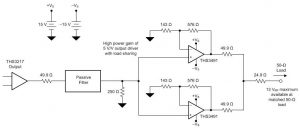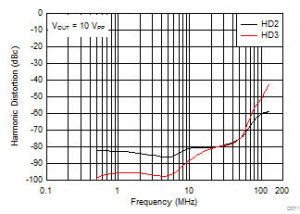
News
TI aims at automotive and industry with high-performance ~30V op-amps
“These are the first few of many other amplifiers focussed in this area, the beginning of a long road of high voltage products,” TI manager of precision amplifier products Marco Gardner told Electronics Weekly.
At the same time, the firm announced a 32V 900MHz CMOS current-feedback amplifier with a high-current output for driving heavy loads (see further down).
In a world where operating voltages are falling, why a new high voltage process?
“In electric and hybrid vehicles, there are a lot of voltages around 48V, and a lot of signal conditioning is needed,” said Gardener. “In industry, there are a lot of sensor nodes far away from their readers, which involve long cables exposed to lightening-induced transients and electro-static discharge. You still have to sense small voltages, but reliably through all that interference.”
OPA2810 is 27V 120MHz rail-to-rail input and output jfet op-amp with 5.7nV/√Hz noise, described by Gardener as “a very good tool-box amplifier for data processing and data acquisition”.
Room temperature input offset is 500μV and current consumption is 3.6mA – the latter allowing Gardener to claim “best-in-class bandwidth/Iq for >12V jfet amplifiers that operate at 120MHz”.
Jfets were chosen at the front end for less input bias current than bipolars, without the noise penalty of a CMOS input. “Jfet gets used in a lot in high-impedance sensors – in high-resolution medical data acquisition, for example,” said Gardener.
OPA189 is a 36V ‘zero-drift’ amplifier – and at 14MHz, industry’s widest bandwidth zero-drift amplifier, according to Gardener: “3-5x faster than anything else that is available”.
Drift is actually 0.02μV/°C on 3μV of offset, with a maximum of 4μV offset over -40 to +125°C, which, according to Gardener, can only be measured because the noise is low enough not to bury it.
Inside is a new topology that achieves 5.2nV/√Hz, “very close to a linear amplifier”, he added. “Ideal for input modules and test and measurement.”
Does it have the unusual noise profile of some zero-drift amplifiers?
“No, with this technique, noise is very similar to a linear amplifier,” said Gardener. And this, he added could help over-come something that not only TI sees as an issue: the reticence among hardware engineers to adopt zero-drift devices despite their intrinsically microscopic input offsets.
“A lot of hardware engineers hesitate to use zero-drift,” said Gardener. “A lot of times the amplifiers are slow, or have noise well above 20nV/√Hz. With this one, you can easily design-out a linear amplifier, reducing or removing the need for calibration.”
What is the topology?
A proprietary hybrid topology with multiple correction paths, was all Gardener was prepared to say until the patent situation is final.
Other specs are: 20V/μs slew-rate, 1.1μs settling to 0.01% from a 10V step and drawing 1.3mA quiescent.
The CMOS amplifier announced at the same time as the two bipolars above is made on an existing 32V CMOS process rather than the new BiCom, and will gladden the heart of anyone designing a signal generator because THS3491 is a 900MHz current-feedback amplifier with a ±420mA output that can drive 10Vp-p into a 100Ω at 200MHz.
“It’s real state-of-the-art for test and measurement,” said Garnener, “Perfect for function generator output stages, and also for driving laser diodes, which look like a high-current high-capacitance load.”
 50Ω function generator output stage drives at >100MHz..
50Ω function generator output stage drives at >100MHz..
It can achieve over-shoot of <1.5% for a 10V step, and rise and fall times of <1.3 ns.
 ..with this output distortion
..with this output distortion
Peak output current is >500mA, allowing heavy capacitive loads to be driven, and output swing is 28Vp-p into 100Ω with ±16V rails.
Slew rate is 8,000V, and there are two package options, a 3x3mm QFN and an SOIC, both heat-sunk for high power delivery. That said, junction to ambient thermal resistance is 44 and 49°C/W respectively, so not all output current and voltage combinations are be possible for very long.
“New designs benefit from the lowest distortion using the VQFN-16 package, whereas the 8pin HSOIC package up-grades existing THS3091 or THS3095 designs because the lower output headroom provides more output swing on ±15V supplies,” said TI.
| Product | Evaluation module | Package |
| OPA2810 JFET-input op amp |
OPA2810DGKEVM | 8 pin SOT-23 8 pin VSSOP |
| OPA189 zero-drift op amp |
DIYAMP-EVM DIP-ADAPTER-EVM |
8 pin SOIC |
| THS3491 current-feedback op amp |
THS3491DDAEVM THS3491RGTEVM |
8 pin SOIC 16 pin VQFN |